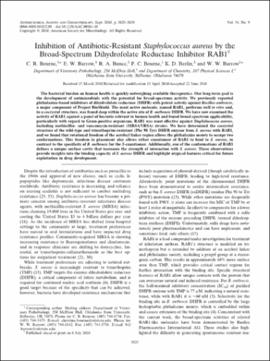| dc.contributor.author | Bourne, C. R. | |
| dc.contributor.author | Barrow, E. W. | |
| dc.contributor.author | Bunce, R. A. | |
| dc.contributor.author | Bourne, P. C. | |
| dc.contributor.author | Berlin, K. D. | |
| dc.contributor.author | Barrow, W. W. | |
| dc.date.accessioned | 2018-08-17T16:24:54Z | |
| dc.date.available | 2018-08-17T16:24:54Z | |
| dc.date.issued | 2010-09 | |
| dc.identifier | oksd_bourne_inhibitionofant_2010 | |
| dc.identifier.citation | Bourne, C. R., Barrow, E. W., Bunce, R. A., Bourne, P. C., Berlin, K. D., & Barrow, W. W. (2010). Inhibition of antibiotic-resistant Staphylococcus aureus by the broad-spectrum dihydrofolate reductase inhibitor RAB1. Antimicrobial Agents and Chemotherapy, 54(9), 3825-3833. https://doi.org/10.1128/AAC.00361-10 | |
| dc.identifier.uri | https://hdl.handle.net/11244/301444 | |
| dc.description.abstract | The bacterial burden on human health is quickly outweighing available therapeutics. Our long-term goal is the development of antimicrobials with the potential for broad-spectrum activity. We previously reported phthalazine-based inhibitors of dihydrofolate reductase (DHFR) with potent activity against Bacillus anthracis, a major component of Project BioShield. The most active molecule, named RAB1, performs well in vitro and, in a cocrystal structure, was found deep within the active site of B. anthracis DHFR. We have now examined the activity of RAB1 against a panel of bacteria relevant to human health and found broad-spectrum applicability, particularly with regard to Gram-positive organisms. RAB1 was most effective against Staphylococcus aureus, including methicillin- and vancomycin-resistant (MRSA/VRSA) strains. We have determined the cocrystal structure of the wild-type and trimethoprim-resistant (Phe 98 Tyr) DHFR enzyme from S. aureus with RAB1, and we found that rotational freedom of the acryloyl linker region allows the phthalazine moiety to occupy two conformations. This freedom in placement also allows either enantiomer of RAB1 to bind to S. aureus, in contrast to the specificity of B. anthracis for the S-enantiomer. Additionally, one of the conformations of RAB1 defines a unique surface cavity that increases the strength of interaction with S. aureus. These observations provide insights into the binding capacity of S. aureus DHFR and highlight atypical features critical for future exploitation in drug development. | |
| dc.format | application/pdf | |
| dc.language | en_US | |
| dc.publisher | American Society for Microbiology | |
| dc.rights | This material has been previously published. In the Oklahoma State University Library's institutional repository this version is made available through the open access principles and the terms of agreement/consent between the author(s) and the publisher. The permission policy on the use, reproduction or distribution of the material falls under fair use for educational, scholarship, and research purposes. Contact Digital Resources and Discovery Services at lib-dls@okstate.edu or 405-744-9161 for further information. | |
| dc.title | Inhibition of antibiotic-resistant Staphylococcus aureus by the broad-spectrum dihydrofolate reductase inhibitor RAB1 | |
| osu.filename | oksd_bourne_inhibitionofant_2010.pdf | |
| dc.description.peerreview | Peer reviewed | |
| dc.identifier.doi | 10.1128/AAC.00361-10 | |
| dc.description.department | Veterinary Pathobiology | |
| dc.description.department | Chemistry | |
| dc.type.genre | Article | |
| dc.type.material | Text | |
| dc.subject.keywords | anti-bacterial agents | |
| dc.subject.keywords | enzyme inhibitors | |
| dc.subject.keywords | inhibitory concentration 50 | |
| dc.subject.keywords | microbial sensitivity tests | |
| dc.subject.keywords | protein structure, secondary | |
| dc.subject.keywords | protein structure, tertiary | |
| dc.subject.keywords | staphylococcus aureus | |
| dc.subject.keywords | tetrahydrofolate dehydrogenase | |
